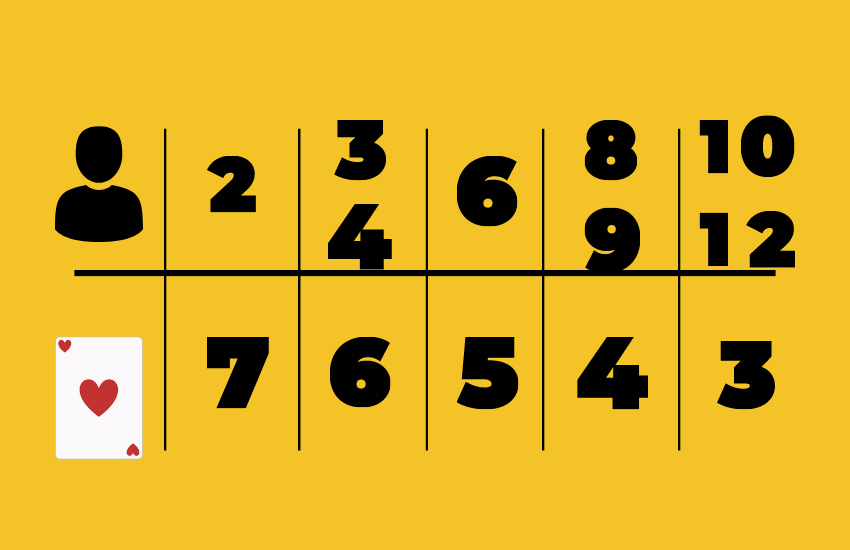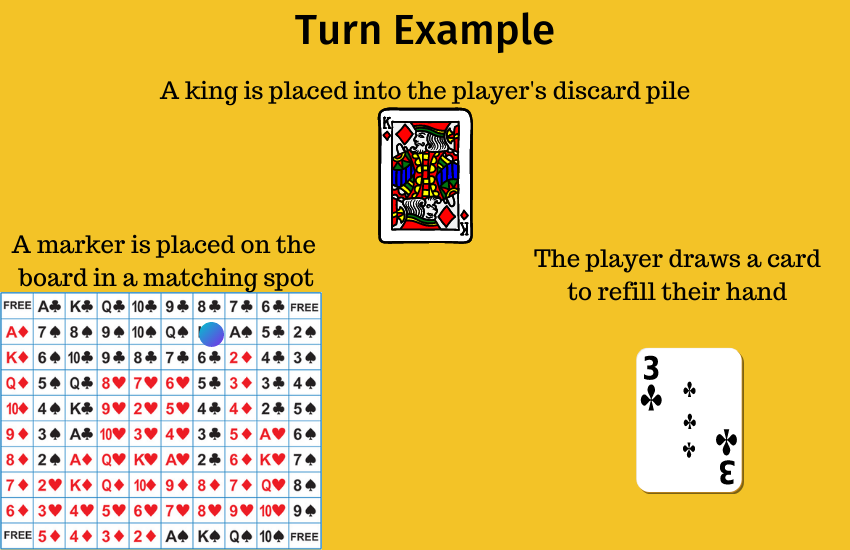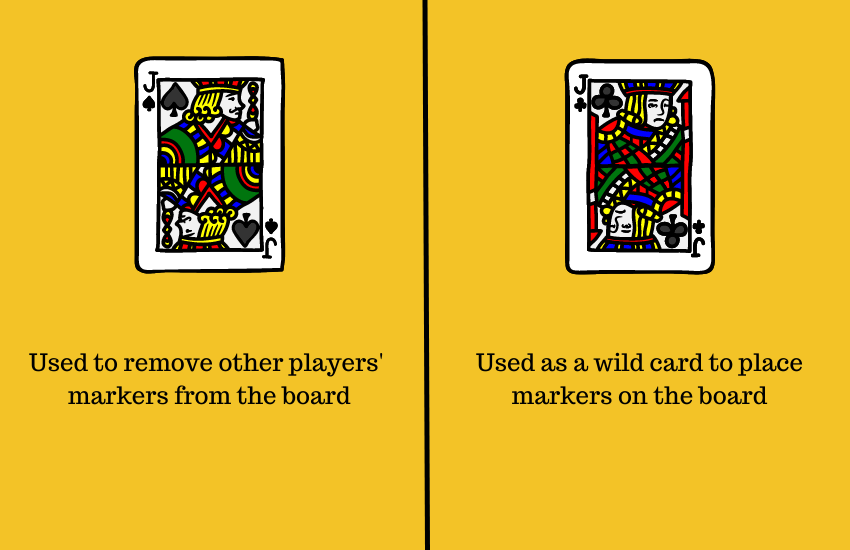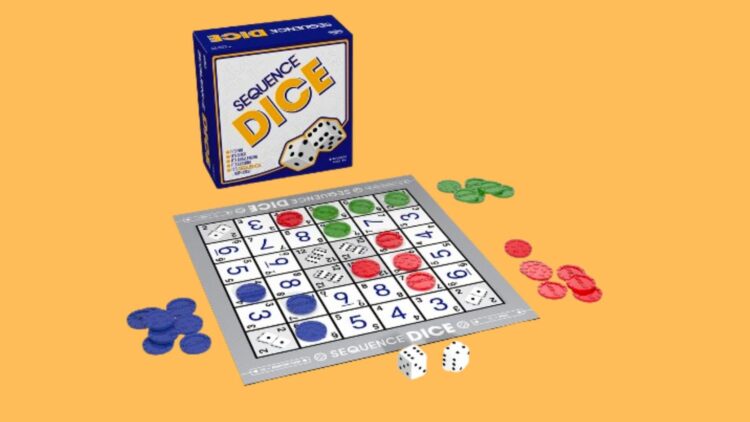
OBJECTIVE OF SEQUENCE: Be the first player to complete the needed sequences.
NUMBER OF PLAYERS: 2 to 12 players (any number from 2 to 12 divisible by 2 or 3)
MATERIALS OF SEQUENCE: A rulebook, a game board, 48 chips each of red, blue, and green, and 104 sequence cards.
TYPE OF GAME: Board Game
AUDIENCE: All ages
OVERVIEW OF SEQUENCE
Reminiscent of Connect 4, Sequence is a relatively simple strategy board game for either 2 or 3 individual players or up to 12 players (as long as the number of players is divisible by 2 or 3). This may seem like a strange rule, but it is necessary in order to complete the needed number of sequences to win the game!
While there is some strategy involved in this, children as young as 6 can absolutely join in on this game for some family fun! Are you getting geared up to play this game? Here are the rules for Sequence.
SETUP FOR SEQUENCE
Of course, before we can get into the rules of the game, it’s important to set up properly for a round of Sequence.
DIVIDE INTO TEAMS
First, you’ll need to pick a number of players and divide everyone into teams. As mentioned above, you can play Sequence with 2, 3, 4, 6, 8, 9, 10, or even 12 players. If there are more than 3 players, you’ll need to evenly divide into 2 or 3 teams.
For example, if there are 6 people playing, you can break up into 2 teams of 3 or 3 teams of 2. Or if there are 9 people playing, break the players up into 3 teams of 3.
Teams must split up in a way that no two teammates sit next to one another. So, at this point in the game, make sure to move around the table if needed! Make sure you have enough space on the table for the board, cards, and chips as well.
DISTRIBUTE THE CHIPS
Now, it’s time to unfold the board and hand out the chips to each player. If there are only two teams playing, you’ll only need the blue and green chips. But if there are three teams, you’ll need the red chips too. Each team can decide which chip color they want, and the chips should be evenly divided among the players of the team.
DEAL THE CARDS

To figure out what team goes first, cut the deck. A player from each team should pick up a part of the deck. Then, look at the bottom card of each deck of cards. And the team with the lowest card deals first.
To deal, shuffle the cards first and deal cards to each player. The number of cards dealt is determined by the number of players:
- 2 players – 7 cards each
- 3 to 4 players – 6 cards each
- 6 players – 5 cards each
- 8 to 9 players – 4 cards each
- 10 or 12 players – 3 cards each
The remaining cards form the draw deck.
HOW TO PLAY SEQUENCE: SEQUENCE RULES
According to the official sequence game rules, the player to the left of the dealer starts the game. Play then proceeds in a clockwise direction.
On a player’s turn, they will take a card of their choice from their hand and play it on their personal discard pile face-up in front of them so other players can see. Then, they will place one of their markers on the matching card on the game board. Players can play on either one of the card spaces as long as they are not already covered by another chip. Once placed on the board, do not remove any chips!
Note: The Sequence board is made up of 100 images of each card of the 2 complete decks of cards – minus the four jacks (more on this later!).

Finally, to mark the end of a turn, players must draw a new card from the draw pile and into their hand. This is IMPORTANT! If you forget to draw a new card before the next player takes their turn, you’ll play the rest of the game with one less card than everyone else!
As you might be able to guess from the game’s name, the goal of the game is to make sequences. You do this by matching 5 of your team’s colored chips in a row on the board. You can do this horizontally, vertically, and diagonally, but they must all be in line with no gaps in between!
If playing with 2 teams, you’ll need 2 completed sequences to win. However, if playing with 3 teams, you’ll need just one sequence to win the game!
CORNER CHIPS
On the Sequence game board, you’ll find 4 corner spaces – these spaces don’t represent any card. You can use these spaces as bonus spaces, so when building a sequence connected to this space, you only need to have 4 cards (instead of 5) to create a sequence.
Interestingly, multiple players can use the same corner spaces at the same time. This means, if Team 1 has 4 blue chips in a row vertically from a bonus corner while Team 2 has 4 blue chips in a row diagonally, both teams have a completed sequence!
JACKS

The reason why there are no jacks on the Sequence board is that they are special cards. There are 8 jacks in total in the deck, and there are two different kinds of jacks.
- One-eyed jack: Play this card to remove another team’s chip from the board. However, you cannot do this to an already-completed sequence.
- Two-eyed jack: Play this card to place a chip wherever you want on the board, even if you don’t have the card.
DEAD CARDS
It is possible to have dead cards in your hand. These are cards you cannot play because both spots are already covered for the card you have. If this happens, simply say “dead card” and put it in the discard pile before you draw a new card and begin your turn.
TABLE TALK
According to official Sequence rules, during this game, members cannot communicate! Do not coach, do not encourage your teammates, and do not discourage them from certain moves or strategies. If a teammate says anything that may indicate how the game should go, every team member must put one card on their discard pile.
DEPLETED DRAW PILE
At some point during the game, the draw deck may become depleted. When this happens, shuffle all the personal discard piles to create a new draw pile.
END OF GAME
The game ends when a player or team completes the needed number of sequences to win. As mentioned, for 2 players or 2 teams, this requires 2 sequences. But for 3 players or 3 teams, this only requires one sequence.
Love Sequence? Then try out Shogi for another fun family strategy game.
VARIATIONS OF SEQUENCE

There are different variations of rules and expansions of Sequence you should check out if you love this game!
- Sequence Dice: Rather than cards, each player must roll two dice to place chips on a board.
- Sequence Stacks: A pure card game, rather than playing chips on a board, players add cards to stacks with the goal of completing sequences. And the first player to earn five chips is the winner.
- Sequence States and Capitals: In this version, match your state card to the same state, shape, and color on the board.
- Jumbo Sequence: A giant version of the classic Sequence game.
- Sequence for Kids: Play a card and place your chip on the corresponding character on the board. The first player or team with four chips in a row wins!
FREQUENTLY ASKED QUESTIONS
How Do I Get Rid of a Dead Card?
To get rid of a dead card, at the beginning of your turn, place it on your discard pile and declare it dead. Then, you may draw a new replacement card and proceed with your turn as normal.
How Many Cards Are Each Player Dealt?
The number of cards dealt to each player is determined by the total number of people playing. For two-player games, both players receive 7 cards each. For games with 3 or 4 players, all players receive 6 cards each. In a 6-player game, each player is dealt 5 cards. For 8 and 9-player games, each player receives 4 cards, and finally, for 10 and 12-player games, 3 cards are dealt to each player.
What Do Jacks Do?
There are two types of jacks in Sequence: one-eyed jacks and two-eyed jacks. The one-eyed jacks allow you to remove another team’s chip off the board, while the two-eyed jacks act as wild cards for you to place a marker wherever you please on the board.
How Do You Win Sequence?
To win Sequence, you must have 5 of your team’s colored markers in a row without any gaps. This can be horizontally, vertically, or diagonally. If there are two teams playing, you’ll need to create two such sequences, but if there are three teams, you’ll need to create just one.
- 12 BEST HARRY POTTER BOARD GAMES - November 16, 2023
- 50 BEST HALLOWEEN GAMES - October 4, 2023
- 50 BEST CHRISTMAS GAMES - September 13, 2023